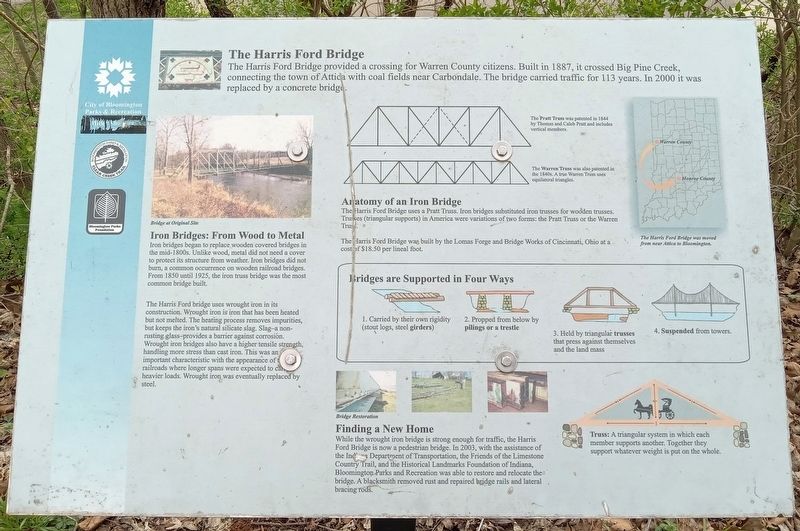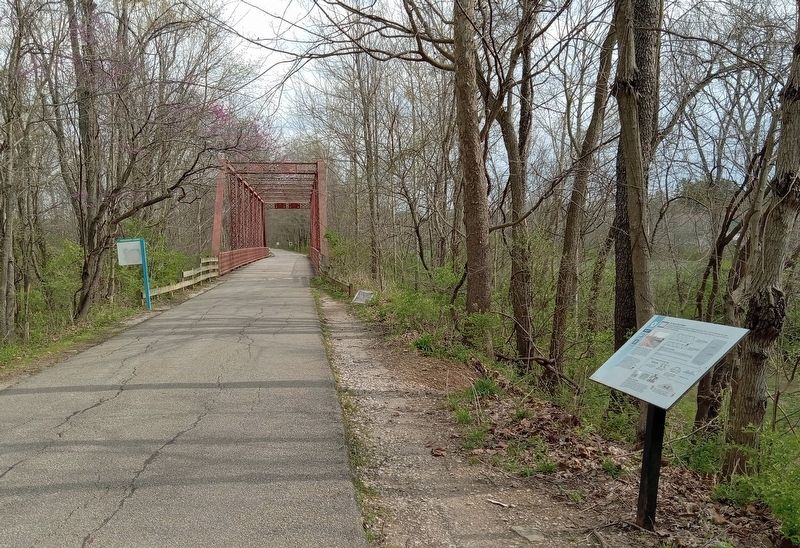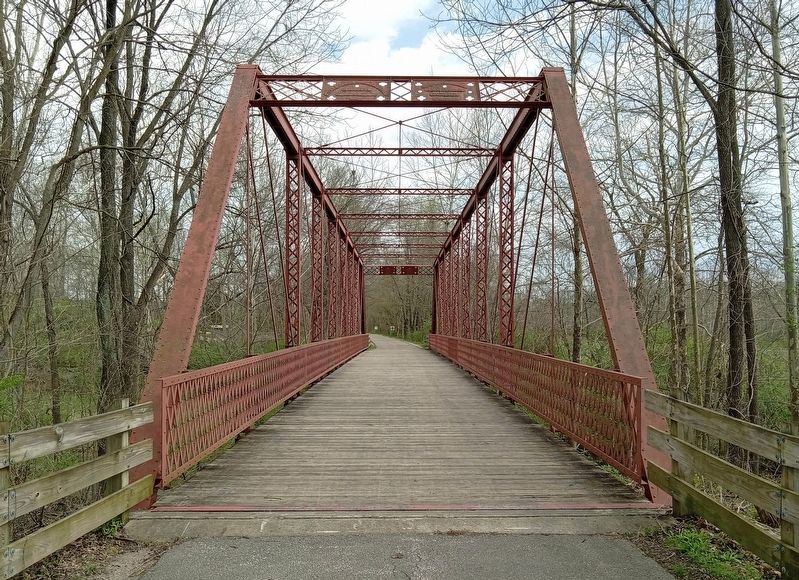Clear Creek near Bloomington in Monroe County, Indiana — The American Midwest (Great Lakes)
The Harris Ford Bridge
The Harris Ford Bridge provided a crossing for Warren County citizens. Built in 1887, it crossed Big Pine Creek, connecting the town of Attica with coal fields near Carbondale. The bridge carried traffic for 113 years. In 2000 it was replaced by a concrete bridge.
The Pratt Truss was patented in 1844 by Thomas and Caleb Pratt and includes vertical members.
The Warren Truss was also patented in the 1840s. A true Warren Truss uses equilateral triangles.
Anatomy of an Iron Bridge
The Harris Ford Bridge uses a Pratt Truss. Iron bridges substituted iron trusses for wooden trusses. Trusses (triangular supports) in America were variations of two forms: the Pratt Truss or the Warren Truss.
The Harris Ford Bridge was built by the Lomas Forge and Bridge Works of Cincinnati, Ohio at a cost of $18.50 per lineal foot.
The Harris Ford bridge was moved from near Attica to Bloomington.
Bridge at Original Site
Iron Bridges: From Wood to Metal
Iron bridges began to replace wooden covered bridges in the mid-1800s. Unlike wood, metal did not need a cover to protect its structure from weather. Iron bridges did not burn, a common occurrence on wooden railroad bridges. From 1850 until 1925, the iron truss bridge was the most common bridge built.
The Harris Ford bridge uses wrought iron in its construction. Wrought iron is iron that has been heated but not melted. The heating process removes impurities, but keeps the iron's natural silicate slag. Slag–a non-rusting glass–provides a barrier against corrosion. Wrought iron bridges also have a higher tensile strength, handling more stress than cast iron. This was an important characteristic with the appearance of the railroads where longer spans were expected to carry heavier loads. Wrought iron was eventually replaced by steel.
Bridges are Supported in Four Ways
1. Carried by their own rigidity (stout logs, steel girders)
2. Propped from below by pilings or a trestle
3. Held by triangular trusses that press against themselves and the land mass.
4. Suspended from towers.
Bridge restoration
Finding a New Home
While the wrought iron bridge is strong enough for traffic, the Harris Ford Bridge is now a pedestrian bridge. In 2003, with the assistance of the Indiana Department of Transportation, the Friends of the Limestone County Trail, and the Historical Landmarks Foundation of Indiana, Bloomington Parks and Recreation was able to restore and relocated the bridge.
A blacksmith removed rust and repaired bridge rails and lateral bracing rods.
Truss: A triangular system in which each member supports another. Together they support whatever weight is put on the whole.
Erected by City of Bloomington Parks & Recreation.
Topics. This historical marker is listed in this topic list: Bridges & Viaducts. A significant historical year for this entry is 1887.
Location. 39° 6.48′ N, 86° 32.6′ W. Marker is near Bloomington, Indiana, in Monroe County. It is in Clear Creek. Marker is on the Bloomington Rail Trail north of W. Church Lane, on the right when traveling north. The marker is just south of the bridge and adjacent to a trailhead parking area off W. Church Lane. Touch for map. Marker is at or near this postal address: 898 W Church Lane, Bloomington IN 47403, United States of America. Touch for directions.
Other nearby markers. At least 8 other markers are within 4 miles of this marker, measured as the crow flies. Industry and Environment (approx. 2.8 miles away); Bringing Light to a Stream (approx. 2.8 miles away); From Cabinets to Radios to Televisions (approx. 2.9 miles away); The Railroad: Bringing Life to Bloomington (approx. 3 miles away); State Seminary of Indiana (approx. 3.7 miles away); Captain Kathryn Janeway (approx. 4 miles away); The Monon Railroad (approx. 4 miles away); Inns and Taverns Cater to New Travelers (approx. 4.1 miles away). Touch for a list and map of all markers in Bloomington.
Credits. This page was last revised on April 16, 2024. It was originally submitted on April 15, 2024, by McGhiever of Minneapolis, Minnesota. This page has been viewed 46 times since then. Photos: 1, 2, 3. submitted on April 15, 2024, by McGhiever of Minneapolis, Minnesota.


